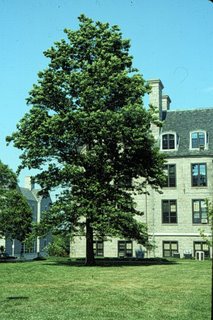By Hazel Barkley
All for the love of trees, Milford had a Tree Warden for the past eight years who dedicated more extra hours to the care and protection of trees than most residents realize, and he took on the job without any extra pay. Irwin Langewisch recently resigned as Milford’s Tree Warden. Because Langewisch, a Milford Public Works employee, had the enthusiasm and skills for the position, Mayor Fred Lisman appointed him according to the requirement of the Connecticut State Statutes, Chapter 451, Sec. 23-58 which states that every city and town in Connecticut must have a tree warden.
Members of the Langewisch family have been supportive of Milford Trees, Inc. (MTI) from the time of its conception. When MTI was forming an ordinance to establish a tree commission in 2000, Irwin was present to help write the document that was later presented to city officials for approval. Irwin’s daughter, Stacy Nobles, a local lawyer, donated her time and energy to drawing up the legal papers that established Milford Trees, Inc. as a nonprofit 501(c)(3). Milford Trees, Inc. is in its seventh year and, along with the Tree Commission, has helped Milford become a model community for urban forestry in the State of Connecticut according to urban forestry leaders at Connecticut Department of Environmental Protection. As Tree Warden, Langewisch played an important role in making Milford a designated CT ReLeaf community. The award was presented by the Connecticut Urban Forest Council for excellence in urban forestry.
With cooperation and support from Bruce Kolwicz, Director of Public Works, Irwin helped Milford Trees, Inc. and the Tree Commission establish a tree nursery at the old sewage treatment plant on Shadyside Lane, hence the name Shadyside Nursery on Gulf Pond. There, Mr. Langewisch dedicated weekday and weekend hours working with MTI volunteers and the Tree Commission members giving much needed advice about trees including getting trees ready for planting in the City’s public spaces, transplanting trees, putting in an electric deer fence, building a watering system, weeding, expanding the nursery as trees grew and training a citizens’ pruning group with co-trainer, Dana Rotman, MTI Board member and Master Gardener. Irwin worked hard with the volunteers on these projects and was dedicated to making Milford’s tree program a success. He was instrumental in getting the trees planted at Monroe St., Shelter Cove and Intervale Pkwy. esplanades, just to name a few planting areas.
As a member of Milford Trees, Inc., Irwin has assured the tree group that he will continue to help out at Shadyside Nursery and see that the trees stay healthy and grow until they reach the size when they can be planted in public areas around the city. Recently, he expanded the nursery containment area. At this time, there are about eight hundred trees of various heights growing under the management of Regine Vitale. As previously mentioned, Langewisch is still a Public Works employee and he will continue to be part of the tree planting crew.
Irwin Langewisch did an outstanding job making tough decisions about tree safety, tree maintenance and tree plantings over the past eight years. Many, many thanks go to Irwin for his eight years of service. He will be missed by many friends and peers!
Milford Trees, Inc.’s President, Mary Ludwig, has been working with Bruce Kolwicz, Director of Public Works, to keep the tree program moving ahead until Mayor Richetelli and the Board of Aldermen appoint another tree warden, hopefully, one as dedicated, as helpful and as knowledgeable as Langewisch has been. According to the Connecticut State Statutes, the position has to be filled within thirty days and Mayor Richetelli has assured the Tree Commission and Milford Trees, Inc. that the position will be filled within that time frame.
Once established, the lines of communication concerning tree planting schedules have run smoothly thanks to Mr. Kolwicz and his Administrative Assistant, Kelly Hammill, and office staff, Lorraine Utz and Lori Weinstein. In the past two weeks, Mr. Kolwicz has stepped in to assure that Milford’s tree program moves ahead. Recently, he took a personal interest in scheduling Ludwig’s request to have the Milford Rotary Club’s two Dawn redwoods planted on either side of River St. at Jefferson and Higby Parks. Last week, a ‘Liberty’ elm, donated by Winthrop Smith, Sr., was planted on The Green along with a second redbud that was donated by Michael Wilcock. The Dawn redwoods and the two redbuds are memorial trees and will be tagged accordingly. Without Kolwicz’s cooperation and helpful scheduling, the trees would still be mulched in at the nursery desperately needing to be planted because of their mature size and heat stress during July and August. MTI volunteers Tammy Jorgensen, Win Smith, Sr. and Mary Ludwig partnered with operational engineers from Public Works including Irwin Langewisch, Kevin O’Donnell, Tom Pollard, Davy Dulin and Charlie Rogers. Public Works foreman, John Wielk, stopped by to see how the tree planting project was going. Many thanks go to all for working so hard in the humid, summer heat.
Considering that the Public Works Office has to deal with complaints about everything under the sun from playgrounds to sidewalks, garbage to sewers, street sweeping to paving, setups to cleanups and on and on, the public rarely thinks about all the helpful and good things that the Pubic Works Department does that makes the lives of Milford’s residents better on a daily basis. Mr. Langewisch and Mr. Kolwicz certainly deserve our thanks for the many ways they are being supportive of our programs, particularly in their willingness to help plant trees in Milford.



